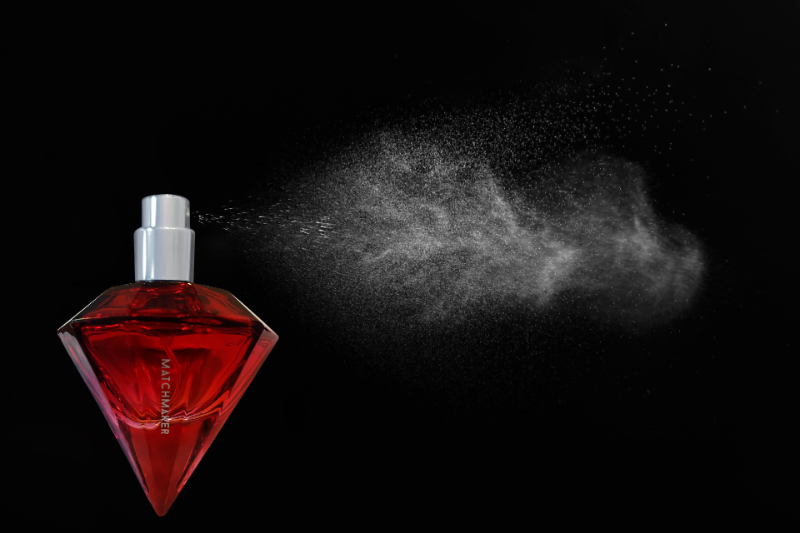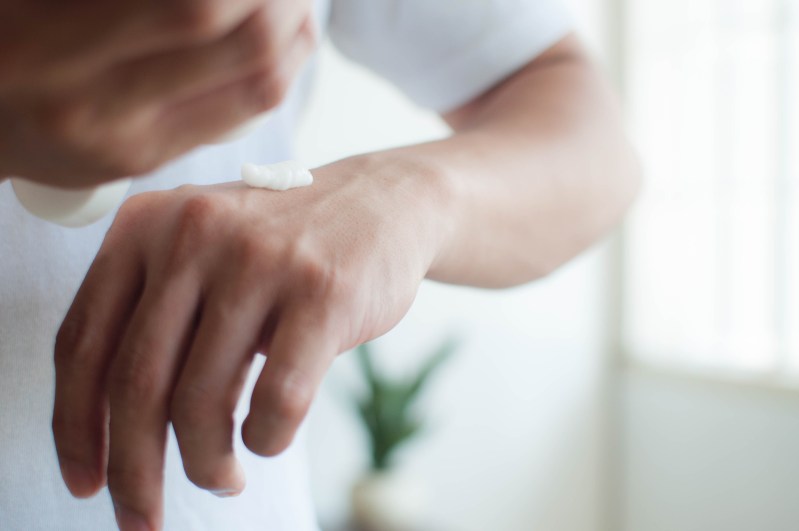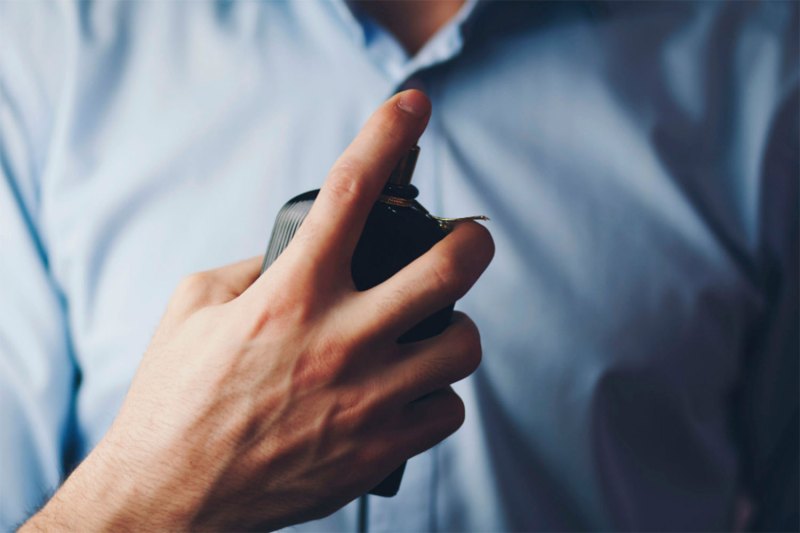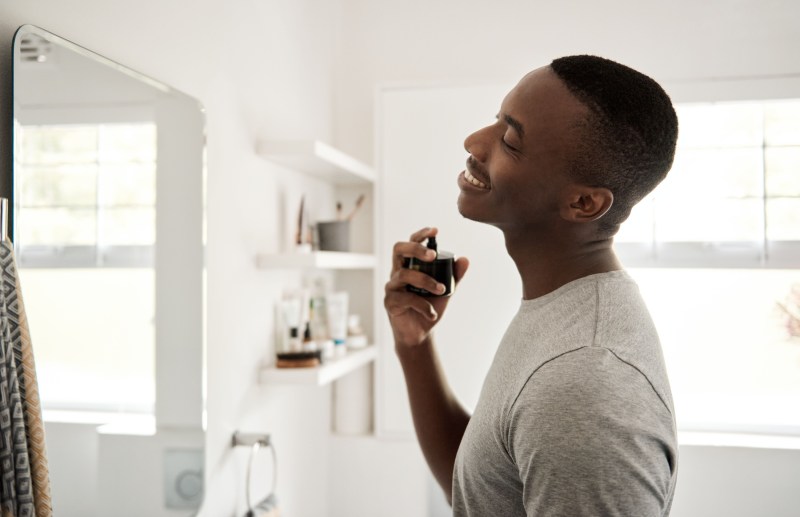
Your scent speaks volumes about you — it works an invisible magic, telling people about your mood, taste, and personality. In classic cartoons, steam wafts from a pie and the scent pulls everyone nearer. Personal fragrance does the same thing. It stirs the imagination of the smeller, all too often holding the attention of passersby in an all-enveloping cloud.
But wearing too much may be one of the best applications of the never-fail rule “less is more.” So, it’s important to learn how to apply cologne to make sure you are on the good side of smell and not leaving a scent that’s too strong. We’ll help make sure you strike the perfect balance between smelling intriguing to others without making them turn their heads away.

A little lesson on scent and how fragrance works
All fragrances are a mixture of oils, alcohol, and water. While the strengths and concentrations vary from one product to another, the higher the percentage, the longer they last on the skin.
Kinds of fragrance
- Traditional colognes don’t pack a huge punch, containing only around 2-4% oil.
- Eau de toilette (EDT in retail lingo) is the next highest concentration of fragrance, and it lasts a bit longer.
- Eau de parfums (EDP) are the heavyweights, with 15-20% oil.
- Pure parfums, as well as extracts, clock in at around 20-30% concentration.
Don’t worry about accidentally purchasing pure parfum or extract — you’ll hear your wallet screaming a warning.
Once released from the bottle, those mixtures will begin to develop into what industry professionals call notes. The top notes are the first aromas that hit your nose, the true first impression. As the alcohol and water evaporate and the oils mix with your body chemistry, the heart, or middle notes, begin to take center stage. Finally, as the day wears on, base notes remain behind. This is also called the drydown.
Fragrances are straight chemistry, and chemistry is all about transformation. Given that changing dynamic, the fragrance also must work with any other scented product you may be using that day. Think about how your scent of choice may interact with anything from shampoo to soap to shaving products to body lotion. Layering fragrances makes them last longer, which is why so many brands will offer a kit of grooming products that all include the signature scent. As with mixology, you may also discover a cocktail of different products that works for you.

Items that leave a fragrance on your skin
Moisturizer
It’s best to start after you’ve showered while your skin is still warm, and your pores are open. Once you are dry, moisturizing your skin will assist the fragrance in absorbing more efficiently, making it last longer. Getting a lotion with a complimentary scent to your cologne is a way to add layers to your scent.
Spray
If you’re using a spray cologne, hold the bottle about six inches from where you want to apply the scent, preferably the upper chest area. Be careful not to rub the product once it is applied as it could damage the molecules and cause them to dissipate faster.
Spritzing your neck is great for a date, but may not be best for an office environment. Keep the fragrance close to your skin and under your clothes to ensure the application stays subtle. Your aim is to be an intriguing mystery, not an air horn.
Wax solid
Solid fragrances are an unexpected scent delivery method, but are also perfect airplane-friendly items for frequent fliers. They offer easy application on the nape of the neck and the wrists, allowing you to swipe and go. In texture, solid fragrances resemble a beeswax-heavy balm and are designed to be rubbed into skin. Remember, less is more, so be frugal with how much you apply.

Cologne applying tips to live by
When to reapply
Your nose will get used to the scent, losing recognition of it after wearing it for a bit. Keep in mind that just because you don’t smell your cologne doesn’t mean your co-workers, date, or friends can’t. You develop nose blindness, or anosmia, throughout the day.
If your scent has proven to be extremely light (citrus-forward scents are notorious for leaving the party early) a discreet reapplication may be in order. A friend or partner could help you identify if a scent tends to stick around or make a quick exit.
How to make cologne last
Like an expensive bottle of liqueur or wine being saved, don’t store cologne in hot places like your bathroom or too near a heat source. Find a room temperature spot, preferably one without strong light. Sun and heat will break down the components faster and make the alcohol and water evaporate sooner.
A fragrance should last about three to four years. Some say to replace in a year, but those people are also probably selling cologne. Rancid oils and a higher concentration of alcohol alters the fragrance and might even harm your skin.
Choosing a fragrance
Choosing the right fragrance in the first place means you don’t have to worry about how long it will last because you’ll wear it fairly often. Think about what kinds of fragrances you already enjoy. Are you into long walks through the woods? Does the smell of baking cookies bring back cozy memories? Do you miss the tobacco smell but are still glad you quit smoking? Any scent that has positive associations for you has probably been worked into a fragrance.
Follow your nose. Many brands now have guides and quizzes on their websites to help buyers discover a combination they’ll like, but there’s nothing like the real thing. Hit the store during off-hours when there are less likely to be salespeople to push the latest designer creation on you. You want a reasonably calm environment in which to see what you’re drawn to. Keep your budget in mind, but there’s nothing wrong with a cologne with a price tag under three digits. Remember that if you (or your significant other) like how a fragrance smells on you, that’s what counts.
Consider the occasion, too. A musky, sexy fragrance may be great for a night out, but if you’re looking for something for the workweek, it might not be the best choice. Your collection may be very minimal, with one scent for day and one for night, or it may expand into eight, one for the office and one for your off time in each season. A lighter fragrance may be better for summer’s heat and humidity, while a warm, woody one feels perfect in winter’s chill. Just like having a perfectly fitted suit or a comfortably broken-in pair of jeans, having the right cologne makes all of the difference in how you wear it.

The right way to wear cologne for the cleanest scent
Do you spray your cologne in a giant cloud of fragrance, let it cover you, and be on your way? If so, then you are doing it wrong. Most people just spray it and go, but there is a science to how to apply cologne to make sure the scent on your skin is as close to what you want as possible.
Before you buy, test it on your skin
If you do get to test it out in a store, you’ll get the closest to how it will smell on you, rather than if you ordered something online. Smell it when you first apply it, an hour later, and then a few hours later to get the whole wheel of scents a fragrance has.
Make sure your skin is clean
You don’t always have to shower to spritz, but you want a clean base. Wash your arms if you’re applying a balm or wax and clean your neck if that’s where the cologne will land. Spraying cologne over dirt and sweat never works out well.
Less is more
We know we already said that, but what it means is to always start with one spray. Only one. Give it a few minutes and see if you like how the scent lands. One more additional spray should be all you need.
Aim for your pulse
Instead of aimlessly spraying all over your body and head, stick to pulse areas like your wrist and neck.
Understanding the tricks of how to apply cologne the right way is just as important as making sure you find one you love. When you have your signature scent picked out and ready to wear, you’ll be able to do it with confidence knowing you won’t cause a stink when you walk in the room.



